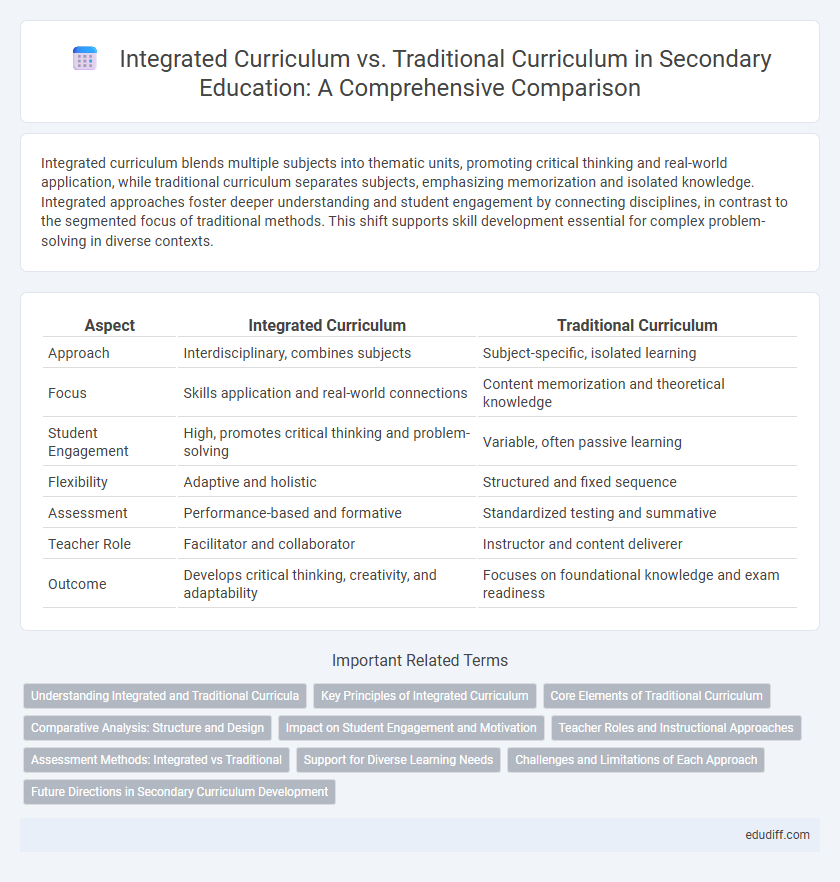Integrated curriculum blends multiple subjects into thematic units, promoting critical thinking and real-world application, while traditional curriculum separates subjects, emphasizing memorization and isolated knowledge. Integrated approaches foster deeper understanding and student engagement by connecting disciplines, in contrast to the segmented focus of traditional methods. This shift supports skill development essential for complex problem-solving in diverse contexts.
Table of Comparison
| Aspect | Integrated Curriculum | Traditional Curriculum |
|---|---|---|
| Approach | Interdisciplinary, combines subjects | Subject-specific, isolated learning |
| Focus | Skills application and real-world connections | Content memorization and theoretical knowledge |
| Student Engagement | High, promotes critical thinking and problem-solving | Variable, often passive learning |
| Flexibility | Adaptive and holistic | Structured and fixed sequence |
| Assessment | Performance-based and formative | Standardized testing and summative |
| Teacher Role | Facilitator and collaborator | Instructor and content deliverer |
| Outcome | Develops critical thinking, creativity, and adaptability | Focuses on foundational knowledge and exam readiness |
Understanding Integrated and Traditional Curricula
Integrated curriculum connects subjects like history, science, and language arts into cohesive learning experiences, enhancing critical thinking and real-world application for secondary students. Traditional curriculum maintains distinct subject boundaries, emphasizing depth and sequential mastery in each area. Understanding these differences enables educators to select approaches that best support student engagement and interdisciplinary skills development.
Key Principles of Integrated Curriculum
Integrated curriculum emphasizes thematic learning, connecting multiple subject areas around a central concept to enhance student engagement and comprehension. It promotes critical thinking, collaboration, and real-world application by breaking down traditional disciplinary silos. This approach supports personalized learning by addressing diverse learning styles and fostering deeper understanding through interdisciplinary connections.
Core Elements of Traditional Curriculum
The core elements of a traditional curriculum center on a structured, subject-based approach emphasizing sequential knowledge acquisition and standardized assessments. It prioritizes foundational disciplines such as mathematics, science, language arts, and social studies, ensuring mastery through repetitive practice and teacher-directed instruction. This curriculum model often follows a fixed timetable and uniform content delivery, reinforcing consistent academic standards across secondary education.
Comparative Analysis: Structure and Design
The integrated curriculum merges multiple subject areas into cohesive units, fostering interdisciplinary connections and real-world application by organizing content thematically rather than by isolated subjects. In contrast, the traditional curriculum maintains distinct subject boundaries with sequential progression, emphasizing depth within individual disciplines and standardized assessment methods. Integrated curricula typically enhance critical thinking and adaptability by promoting holistic understanding, while traditional designs prioritize mastery of specific content knowledge through structured, compartmentalized learning.
Impact on Student Engagement and Motivation
Integrated curriculum in secondary education enhances student engagement by connecting multiple subjects through real-world applications, fostering deeper understanding and intrinsic motivation. Traditional curriculum often segments subjects, which can limit student interest and reduce the relevance of learning to everyday experiences. Research indicates that integrated approaches increase motivation by promoting active participation and making learning more meaningful for adolescents.
Teacher Roles and Instructional Approaches
In secondary education, integrated curriculum encourages teachers to adopt facilitator and collaborator roles, promoting interdisciplinary connections and student-centered learning, while traditional curriculum positions teachers primarily as knowledge transmitters using subject-specific, lecture-based instruction. Integrated approaches emphasize inquiry-based, project-oriented activities, fostering critical thinking and real-world application, contrasting with the structured, content-focused delivery typical in traditional settings. Effective implementation of integrated curriculum requires teachers to design flexible, thematic lessons that cater to diverse learning styles and promote active engagement across disciplines.
Assessment Methods: Integrated vs Traditional
Assessment methods in integrated curricula emphasize interdisciplinary projects, performance tasks, and formative evaluations that measure students' ability to apply knowledge across subjects, fostering critical thinking and problem-solving skills. Traditional curricula primarily rely on standardized tests and subject-specific exams, focusing on memorization and discrete content mastery. The integrated approach provides a more holistic assessment, capturing a student's comprehensive understanding and real-world application.
Support for Diverse Learning Needs
Integrated curriculums provide tailored learning experiences by combining multiple subjects, addressing diverse learning styles and promoting deeper understanding. Traditional curriculums often follow rigid structures, which may limit flexibility in accommodating individual student needs. Support for diverse learners is enhanced in integrated approaches through interdisciplinary strategies and collaborative learning opportunities.
Challenges and Limitations of Each Approach
Integrated curriculum faces challenges such as increased demand on teachers' interdisciplinary expertise and difficulties in standardizing assessment across subjects. Traditional curriculum limitations include fragmented learning experiences and reduced opportunities for critical thinking, leading to student disengagement. Both approaches require careful balancing of content depth and breadth to optimize educational outcomes.
Future Directions in Secondary Curriculum Development
Future directions in secondary curriculum development emphasize integrating interdisciplinary approaches within both integrated and traditional curriculums to promote critical thinking and real-world application. Technology-enhanced learning tools and personalized learning pathways are increasingly incorporated to cater to diverse student needs and foster 21st-century skills. Research indicates that hybrid models combining structured content with thematic, integrated units yield improved academic outcomes and student engagement in secondary education.
Integrated Curriculum vs Traditional Curriculum Infographic

 edudiff.com
edudiff.com